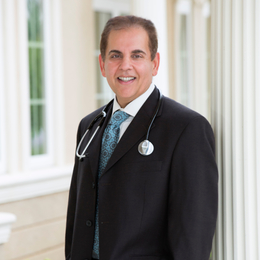
WHEN SPEAKING WITH A CARDIOLOGIST, the issues that are most commonly discussed are vascular disease and blockages in the arterial system. But another shared issue among 40 percent of the U.S. population that isn’t frequently talked about is venous reflux disease—which falls under the realm of cardiovascular disease. Suburban Family had the chance to speak with Dr. Vic Bahal of Advanced Cardiology of South Jersey about the causes and treatment for chronic venous disease.
Understanding the disease
When veins operate properly, they carry blood north to the heart. But those with chronic venous disease (CVD) experience something called reflux, when the blood trickles back down through the veins due to valves that are damaged as the result of aging, high blood pressure and obesity, to name a few reasons.
“You know when we talk about vascular disease we often refer to blockages in the arterial system,” says Dr. Bahal. “But—by and large—the veins are affected more in our legs than in our arteries.
“[Chronic] venous disease is preferentially more common than heart disease, congestive heart failure, stroke, arterial disease and affects millions of Americans across the nation,” he says. “It is one of the most under-diagnosed, undertested and undertreated medical problems in America.
“We’re treating a lot of people with venous reflux disease and if it’s left untreated, can lead to disastrous consequences,” says Dr. Bahal. “In fact, 80 to 90 percent of all ulcers in legs are venous ulcers. Every year, 500,000-600,000 people in the U.S. will develop vein ulcers if not treated in an appropriate time frame.”
Surprisingly, there are more signs of vein disease than you’d expect. Symptomatic varicose veins are a big indicator of vein disease, as well as tingling, pain, numbness, heaviness, cramping, soreness or restlessness in the legs, toe cramping at night and itching.
“Also, any individual with darkening of the color of skin in their legs should be evaluated regardless of symptoms,” he continues. “They may possess some form of venous reflux which should be proactively tested and treated if deemed necessary.”
What are the causes?
As with many diseases, there are things that we do as humans that can help prevent our chances of developing CVD and those that can increase it.
Obesity plays a large factor in developing CVD, but is not the only one. Smoking can increase your chances of developing the disease, as well as pregnancy or having blood clots. But Dr. Bahal says, “Risk factor modification in this disease does not go that far.”
Professionals who spend a lot of time on their feet, like teachers and nurses, will actually wear compression stockings even if they don’t have CVD, just to take the extra measure to make sure that it doesn’t develop.
Unlike cardiac or arterial diseases that can be modified, vein disease is more anatomic. Dr. Bahal says once vein disease does damage to your valves, it can’t be salvaged.
“Vein disease is more common in women than in men. If it is left untreated, it can lead to a breakdown of the skin and not only is that cosmetically unappealing, but more so it exposes you to forming ulcers in your leg and as the skin breaks down you get infections,” says Dr. Bahal. “A condition called stasis dermatitis is the result of untreated venous insufficiency.”
Interestingly enough, men develop CVD usually later in life during their 60s and 70s; however over the past three years Advanced Cardiology has been seeing them presenting in their 40s and 50s. Women predominantly develop vein disease as early as age 40. There is also a big hereditary risk with this disease. Dr. Bahal had a consultation with a patient recently who was 35 years old and had three other female family members who all had CVD just like her. “Family history is very important,” he says. “There is a genetic transmission with this disease.”
Getting treatment
To find out if you have significant venous reflux—meaning more than 0.5 of a second—the Advanced Cardiology office will perform a venous duplex ultrasound to see how long that vein segment is refluxing (going in the wrong direction).
“The first line of defense is compression stockings [which] the patient wears for at least 90 days and then most insurances will approve [the] procedure I perform,” says Dr. Bahal. “[It’s] a quick in-and-out procedure that takes about an hour or less in my office; no incision and it’s all done through a tiny needle. At the end of the procedure the patient walks out of our office and can return to work the next day. This is called radiofrequency ablation/venaseal procedure and it cures chronic venous reflux disease.”
These treatments go beyond just the surface appearance. “Many men and women don’t realize there is a medical component to address first. They will visit medical spas for cosmetic sclerotherapy treatment for unsightly veins but they cannot address the issue from a medical standpoint,” says Dr. Bahal. “That is what distinguishes the Vein Clinic at Advanced Cardiology. The root cause is the disease, and once we treat that, we have better outcomes and prevent the recurrence of spider veins and reticular veins on legs.”
Patients not only have more confidence in their appearance, but have relief from the symptoms they’ve endured for years. “Being a preventative doctor as I am, we do a lot of medically necessary vein testing and the outcome has been very favorable,” says Dr. Bahal. “Legs look better, but disease pain symptoms can go away as early as two to three days after the procedure has been done.
“If left untreated, it can create havoc; some people have lost their limbs because of this [disease]. It can be a catastrophic problem,” says Dr. Bahal. “This has to be on the forefront of medicine: the detection and treatment of this disease.”
To find out more about a vein disease or to have vein evaluation, call Dr. Bahal at Advanced Cardiology of South Jersey at (856) 241-3838.
Advanced Cardiology of South Jersey
Mullica Hill
(856) 241-3838
AdvancedCardiologySJ.com
Photography by Alison Dunlap
Published (and copyrighted) in Suburban Family Magazine, Volume 11, Issue 7 (September 2020).
For more info on Suburban Family Magazine, click here.
For information about advertising in Suburban Family Magazine, click here.
To find out where to pick up your copy of Suburban Family Magazine, click here.




